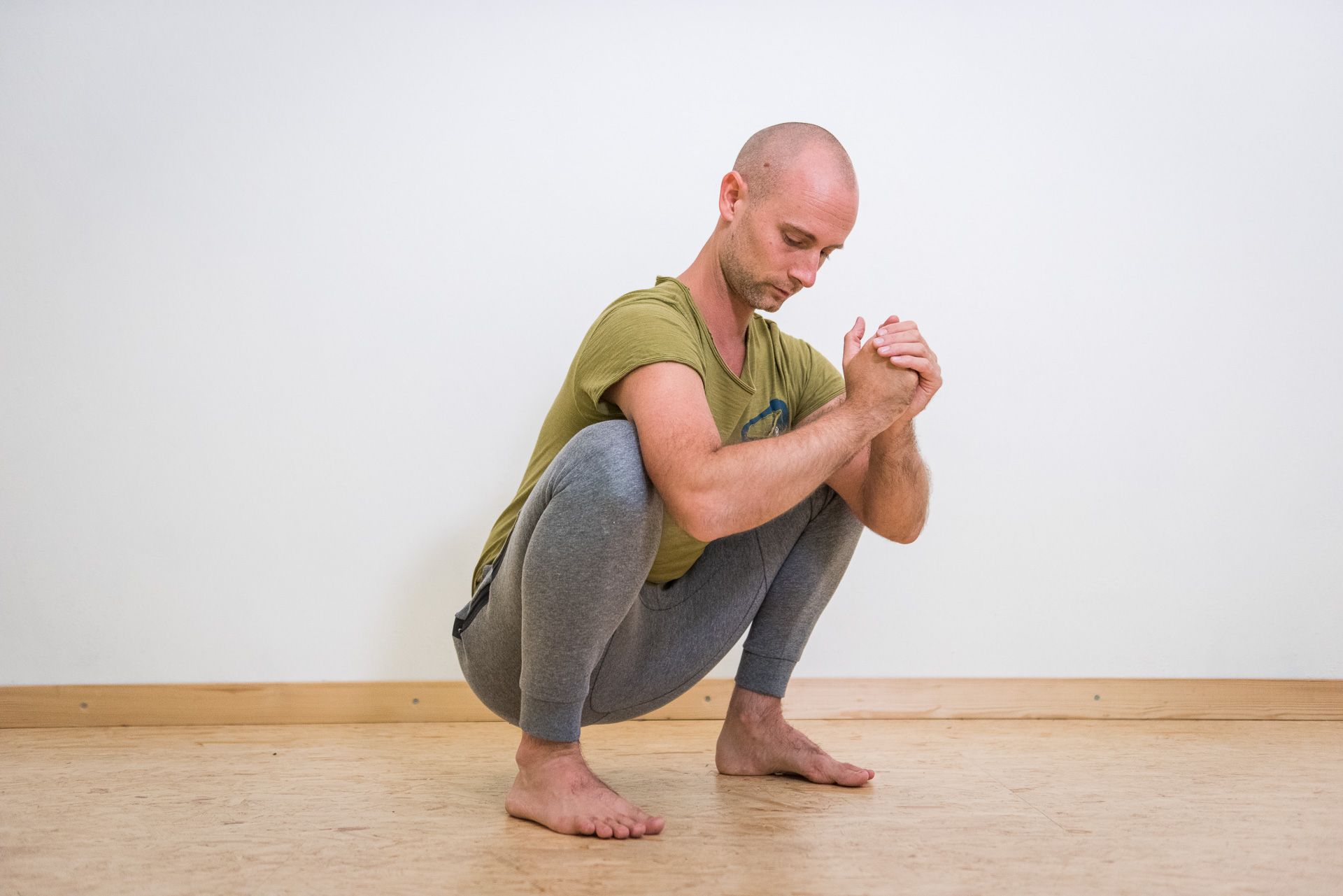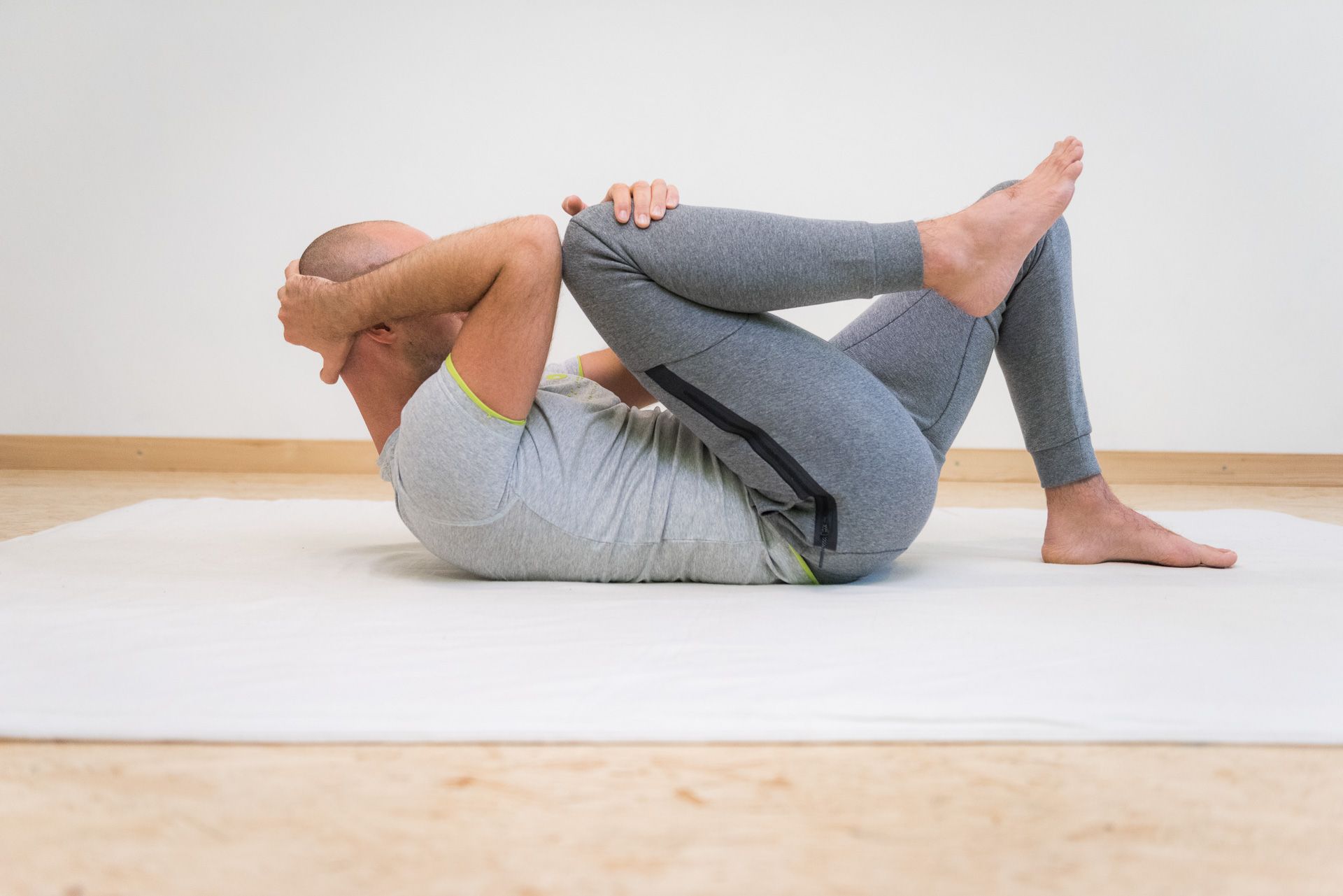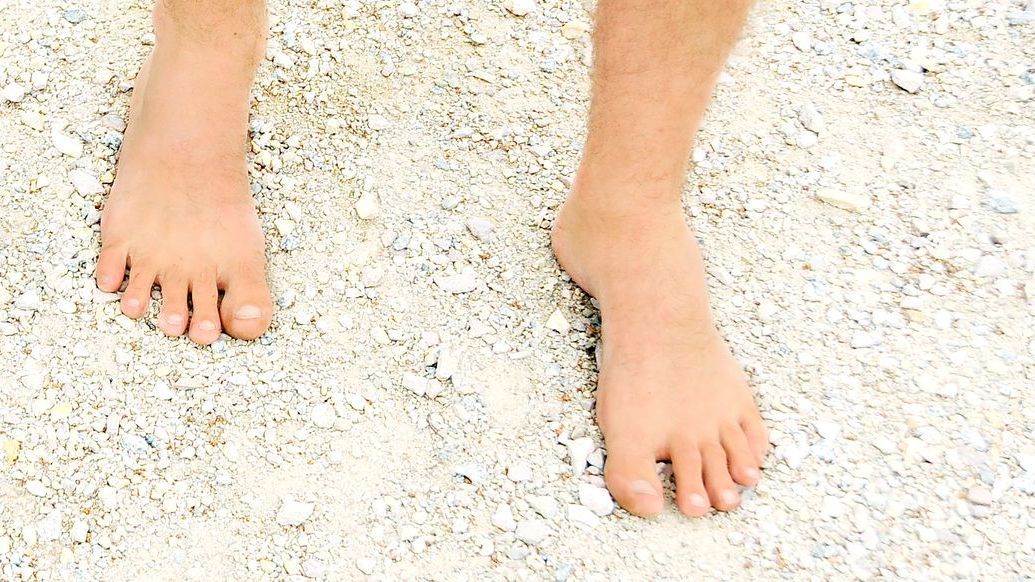The forgotten art of sitting
Reading time for this text: about 6 minutes.
„No matter how perfectly arranged your computer workstation, it cannot protect you from the potential hazards of hours of stagnancy. The only truly ergonomic workstation is one that you regularly push away from!“ (Paul Ingraham)
The forgotten art of sitting
In December 2016, I discussed for the first time with a carpenter friend what I now offer companies as a workshop and lecture as part of workplace health promotion. We are talking about the art of sitting. Because in addition to the fact that sitting often has unfavorable effects on our health, it also has a potential that many people do not recognize: Sitting can become mobility training and thus — in addition to important breaks for exercise — bring healthy variety into our often one-sided, static, sedentary everyday lives. This potential can be developed not only in the office, but also when working from home.
The origins of the workshop can be found in various movement disciplines. Static gymnastics training on the mat and methods of movement on the floor from martial arts provided the basic principles, which were refined in my many years of working with groups in back training.
But “The forgotten art of sitting” has more in mind. It is about identifying the problems and possibilities of sitting based on scientific research, debunking myths, finding solutions suitable for everyday use and at the same time considering the requirements of companies. Because we should never lose sight of the fact that sitting is a significant part of our modern working world and enables us to work attentively and concentrated at our desks uniquely.
Cardiovascular and metabolic diseases due to frequent and uninterrupted sitting?
On average, people in Germany sit for 9.2 hours a day, half an hour more than during the coronavirus pandemic: we sit at our desk at work, in our home office or in the car, and at home on the couch, at the dining table or on the terrace. Sitting takes up a significant part of our modern lives. In our private lives, we could put a stop to these sitting orgies by adapting our behavior. At work, whether in the office or working from home, this is not always possible due to working methods, unfavorable furniture or simply a lack of or incorrect knowledge of the subject. Either way, however, it would be necessary to limit daily sitting times, as sitting for long periods is bad for our health. According to a meta-analysis of 34 studies, a threshold value of six to eight hours of daily sitting and three to four hours of daily television consumption indicates an increase in the risk of cardiovascular disease and type 2 diabetes.
According to a 2019 study of 5,638 women, frequent, long periods of sitting without a break are particularly problematic in terms of cardiovascular disease. Prolonged, frequent sitting also appears to increase the risk of cancer, although the influencing factor of obesity should also be considered here. According to the scientific community, frequent sitting without breaks and the associated lack of movement has a negative effect on metabolic processes — a fact that, in my opinion, has not even required any studies.
After long periods of sitting, even training sessions may no longer be able to compensate for the negative effects of sitting. It therefore remains to be said that we should generally avoid sitting for long periods of time.
At the same time, other studies suggest that 60 to 75 minutes of moderately intensive exercise per day can mitigate the negative health effects of sitting for up to eight hours a day. So, there is hope — if you're ready to take action.
Back pain and neck problems due to a lack of exercise breaks and static sitting?
But there are not only negative effects on the cardiovascular system and metabolism. Personally, I have repeatedly heard reports of orthopedic issues such as back pain and neck pain caused by sitting.
However, a fairly recent meta-study from 2022, which analyzed 16 studies with over 100,000 participants, showed that sedentary activities between three and eight hours a day were not associated with the development of lower back pain. In addition, however, the results showed that sedentary work for more than three hours a day can lead to a worsening of pre-existing lower back pain. However, as the included studies on the worsening of pain were mostly of mediocre quality, the results should be taken with a grain of salt, according to the study initiators.
Some other studies, however, point to a link between frequent sitting and the number one musculoskeletal disorders of neck pain and lower back pain among adults.
A first meta-analysis on the risk factors for neck pain in students in 2023 came to the conclusion that factors such as lack of exercise, incorrect sitting posture, intensive smartphone use with lowered head, high stress and emotional problems can be important risk factors for neck pain. Although it was not explained what exactly is meant by an incorrect sitting posture.
The study results regarding a connection between musculoskeletal disorders and the sitting factor are therefore rather inconsistent.
Nevertheless, the way we sit can certainly have an influence on back or neck pain. The influence — and therefore potential solutions — are individual, though. Variability in sitting posture, improving posture and increasing movement can therefore help to reduce pain on an individual basis.
What we can establish in the context of musculoskeletal disorders is that a significant factor is not sitting per se, but the lack of movement and variety while sitting. According to one study, back pain patients sit more statically, i.e., they make fewer micro-movements while sitting and continue to sit for longer without interruption.
The first part of the solution is to plan regular micro-movement breaks. These have already been well researched in terms of their health benefits and are easy to incorporate into everyday working life.
However, there is also the exciting question of whether and, if so, how we can bring more movement into sitting itself. After all, our musculoskeletal system wants to be moved, and we can enable it to do so even while sitting!
A new approach to sitting
Although traditional advice on sitting ergonomics has now actually recognized that it is not the sitting position itself but the dynamics of sitting — and therefore the change of sitting positions — that is decisive, their recommendations still talk about “correct” sitting and the reference sitting posture. They continue to recommend a supposedly optimal sitting posture with concrete specifications such as: firm contact with the backrest, a lower thigh angle of at least 90 degrees, at least two finger-widths of space between the edge of the seat and the hollow of the knee, and ideally with an adjustable lumbar support that adapts to the curvature of our lumbar spine — to name just a few specifications.
I don't want to criticize these specific specifications, as they are partly based on a comprehensible approach. But in terms of a desirable dynamic of sitting, this seating standard restricts us enormously and deprives us of an incredible number of sitting options and therefore valuable movement. Furthermore, the division into “correct” and “incorrect” sitting is scientifically untenable.
However, it is not only this standard that restricts us. The seating furniture we use, the swivel desk chair, restricts us even more. This is because, apart from a few smaller seating variants (here we are talking about dynamic sitting in front, middle and back postures), it does not offer us any real alternatives.
Two other major disadvantages of swivel desk chairs from a movement perspective are, firstly, that the chair itself rotates, often depriving our spine of the important rotational movement. And secondly, as crazy as it may sound, today's swivel desk chairs are too comfortable and therefore often prevent movement, such as standing up regularly. In both cases, it means more static sitting, less movement and therefore a higher health risk.
Fortunately, many companies have recognized this problem and offer employees standing desks as an alternative. According to a meta-analysis, sit-stand workstations have the potential to reduce lower back pain - even if further studies are required. But standing desks and standing can also cause discomfort, especially regarding the duration of standing and the floor conditions and thus put unnecessary strain on our musculoskeletal system and make productive work more difficult.
What standing desks also cannot achieve is a desirable change in sitting position with joint angles for the ankle, knee and hip joints that are completely unknown for our sitting conditions. We are familiar with these sitting variations from gymnastics (long seat, straddle seat), meditation (cross-legged seat) or from Japanese sitting culture (Seiza heel seat or the Kiza sitting posture of the Samurai).
The prerequisite for adopting such sitting postures, especially for working from home, is a mat on the floor and a low table, such as a coffee table, on which a mouse, keyboard and screen or laptop can be placed. Tips from classic sitting ergonomics, such as sloping shoulders, resting forearms and wrists that are not bent, are also helpful here regarding the neck-shoulder-arm complex. On the floor, you can switch back and forth between different sitting positions without any restrictions.
For seated work at a desk, a large, height-adjustable upholstered stool with a firm seat, such as those used as an addition to sofas, is ideally suited. As no special seating furniture is currently built for this application, you have to improvise a little for the time being. I am currently using an upholstered stool with a seat measuring 90 x 75 cm. However, there are also larger square models measuring 100 x 100 cm or rectangular models up to 140 cm wide, which are definitely preferable for space-consuming seating variants such as the straddle seat. The main limiting factor here is, of course, the space available at or around the desk. Aids such as meditation or wedge cushions, which make new and unfamiliar sitting positions such as sitting cross-legged or on your heels easier by using them on the poster stool, are also permitted and desirable. Such a simple stool allows a wide range of movement and a maximum number of sitting variations and is therefore, from a movement perspective, preferable to special and often much more expensive alternative seating furniture (saddle or pendulum stools, kneeling chairs, sitting balls, etc.). A sturdy upholstered stool is also preferable to sitting balls or pendulum stools in terms of the risk of accidents.
Note: According to the current technical rules for workplaces for VDU work (ASR A6) from the Committee for Workplaces (as of July 2024), such an upholstered stool should fall under alternative seating furniture and could be used temporarily as training and exercise equipment.

Summary for practical implementation
- Exercise regularly in your free time before or after sedentary work: 60–75 minutes of moderate-intensity exercise. Exercise should ideally take place daily.
- Plan micro-exercise breaks between periods of sitting: 10–15 minutes cumulatively per day makes sense here. According to a large-scale Danish study, short exercise breaks can prevent around 10% of long-term absences from work.
- Alternate your working position between standing and sitting, and walk whenever possible:
- Standing and sitting in a 1:1 ratio, plus walking for 10 minutes 3–4 times a day at best. So-called walking pads (desk treadmills) can also be used here and are particularly useful for tasks such as phone calls.
- Integrate movement while sitting: Sitting can become flexibility training. Sitting is stretching and maximum flexion of joints. Sitting is the recapture of movement radii. Sitting is variety. When used correctly, sitting is movement. Everything is allowed. From the deep squat to the cross-legged position, to seiza (sitting on the heels) or kiza (the sitting posture of the samurai), to the straddle or long seat from gymnastics, to our well-known upright sitting posture from sitting ergonomics. The different sitting positions allow us to move the joints downwards from the hips in a variety of ways, sometimes through their entire range of motion. Sometimes we are stretched out in a slight extension. Other times a joint is compressed and thus flexed. A consistently movement-oriented approach that for the first time provides real variance when sitting. For example, use an upholstered stool as described above and regularly switch between different sitting positions.
Drachentöter Fitness workplace health promotion workshop and lecture “The forgotten art of sitting”
The lecture and practical workshop provide companies and the self-employed with all the knowledge already outlined in the blog post above in an entertaining way with scientific underpinning.
Both the one-hour lecture “The forgotten art of sitting” and the 120-minute practical workshop for up to 20 people are offered directly on site in companies and deal with the following content:
- Why do companies benefit from addressing the issue of sitting?
- Is sitting really as bad as its reputation?
- Is it even possible to sit “correctly” and “incorrectly”?
- Is a sitting ergonomics consultation a sufficient solution?
- Why can ergonomic swivel desk chairs become a problem?
- Are standing desks the only alternative to traditional sitting?
- Why can standing desks also become a problem?
- What other solution options are there, and how can I implement them?
- The model of competence stage development from developmental psychology (the four stages of competence development) regarding unconscious movement and posture patterns when sitting
- The art of sitting: possible sitting postures and their variations in theory and practice
- Suggested solutions and approaches for challenging sitting postures, limited mobility and individually unfavorable sitting posture patterns
- Pelvis, ischial tuberosity, spine, rib cage and shoulder girdle when sitting (and standing)
- Mobilization of the spine during different sitting postures
- The value of transitions from sitting posture to sitting posture
- Notes on the subject of breathing
- Implementing the art of sitting in the home office and in the office (relationship versus behavioral prevention)
- What influence do movement breaks have, and how should they be designed?
- Insight into the concept of micro-movement breaks and how best to organize them
– Thomas

References:
- Agarwal S, Steinmaus C, Harris-Adamson C. Sit-stand workstations and impact on low back discomfort: a systematic review and meta-analysis. Ergonomics. 2018 Apr;61(4):538-552. doi: 10.1080/00140139.2017.1402960. Epub 2017 Dec 4. PMID: 29115188. https://pubmed.ncbi.nlm.nih.gov/29115188/
- Alzahrani H, Alshehri MA, Alzhrani M, Alshehri YS, Al Attar WSA. The association between sedentary behavior and low back pain in adults: a systematic review and meta-analysis of longitudinal studies. PeerJ. 2022 Mar 28;10:e13127. doi: 10.7717/peerj.13127. PMID: 35391924; PMCID: PMC8983064. https://www.ncbi.nlm.nih.gov/pmc/articles/PMC8983064/
- Andersen LL, Skovlund SV, Vinstrup J, Geisle N, Sørensen SI, Thorsen SV, Sundstrup E. Potential of micro-exercise to prevent long-term sickness absence in the general working population: prospective cohort study with register follow-up. Sci Rep. 2022 Feb 10;12(1):2280. doi: 10.1038/s41598-022-06283-8. PMID: 35145176; PMCID: PMC8831624. https://www.ncbi.nlm.nih.gov/pmc/articles/PMC8831624/9
- Bellettiere J, LaMonte MJ, Evenson KR, Rillamas-Sun E, Kerr J, Lee IM, Di C, Rosenberg DE, Stefanick M, Buchner DM, Hovell MF, LaCroix AZ. Sedentary behavior and cardiovascular disease in older women: The Objective Physical Activity and Cardiovascular Health (OPACH) Study. Circulation. 2019 Feb 19;139(8):1036-1046. doi: 10.1161/CIRCULATIONAHA.118.035312. PMID: 31031411; PMCID: PMC6481298. https://www.ncbi.nlm.nih.gov/pmc/articles/PMC6481298/
- BG BAU - Berufsgenossenschaft der Bauwirtschaft. Ergonomisch sitzen – Richtiges Sitzen. https://www.bgbau.de/themen/sicherheit-und-gesundheit/ergonomisches-arbeiten/buero-und-bildschirmarbeitsplaetze/ergonomisch-sitzen (August 2024)
- Bundesanstalt für Arbeitsschutz und Arbeitsmedizin (BAuA). (Ausgabe Juli 2024). Technische Regel für Arbeitsstätten – ASR A6 Bildschirmarbeit. https://www.baua.de/DE/Angebote/Regelwerk/ASR/ASR-A6 (Seite 20)
- da Costa L, Lemes IR, Tebar WR, Oliveira CB, Guerra PH, Soidán JLG, Mota J, Christofaro DGD. Sedentary behavior is associated with musculoskeletal pain in adolescents: A cross sectional study. Braz J Phys Ther. 2022 Sep-Oct;26(5):100452. doi: 10.1016/j.bjpt.2022.100452. Epub 2022 Oct 13. PMID: 36257097; PMCID: PMC9579307. https://www.ncbi.nlm.nih.gov/pmc/articles/PMC9579307/
- DKV Deutsche Krankenversicherung AG (2023). DKV-Report 2023: Deutsche lassen ihre Gesundheit sitzen. Sitzzeiten brechen erneut bisherigen Rekordwert und das psychische Wohlbefinden leidet. https://www.dkv.com/downloads/Medieninformation_DKV-Report_2023.pdf (August 2024)
- Ekelund U, Steene-Johannessen J, Brown WJ, Fagerland MW, Owen N, Powell KE, Bauman A, Lee IM; Lancet Physical Activity Series 2 Executive Committe; Lancet Sedentary Behaviour Working Group. Does physical activity attenuate, or even eliminate, the detrimental association of sitting time with mortality? A harmonised meta-analysis of data from more than 1 million men and women. Lancet. 2016 Sep 24;388(10051):1302-10. doi: 10.1016/S0140-6736(16)30370-1. Epub 2016 Jul 28. Erratum in: Lancet. 2016 Sep 24;388(10051):e6. doi: 10.1016/S0140-6736(16)31677-4. PMID: 27475271. https://pubmed.ncbi.nlm.nih.gov/27475271/
- Gao Y, Chen Z, Chen S, Wang S, Lin J. Risk factors for neck pain in college students: a systematic review and meta-analysis. BMC Public Health. 2023 Aug 8;23(1):1502. doi: 10.1186/s12889-023-16212-7. PMID: 37553622; PMCID: PMC10408143. https://www.ncbi.nlm.nih.gov/pmc/articles/PMC10408143/
- Gilchrist SC, Howard VJ, Akinyemiju T, et al. Association of Sedentary Behavior With Cancer Mortality in Middle-aged and Older US Adults. JAMA Oncol. 2020;6(8):1210–1217. doi:10.1001/jamaoncol.2020.2045. https://jamanetwork.com/journals/jamaoncology/fullarticle/2767093
- Hermelink, R., Leitzmann, M.F., Markozannes, G. et al. Sedentary behavior and cancer–an umbrella review and meta-analysis. Eur J Epidemiol 37, 447–460 (2022). https://doi.org/10.1007/s10654-022-00873-6. https://link.springer.com/article/10.1007/s10654-022-00873-6#Abs1
- Huberman, AD., @hubermanlab, Health symposium @StanfordMed. https://x.com/hubermanlab/status/1491917550195597322?lang=de (August 2024)
- Ingraham, Paul (2022). Microbreaking: Lots of little breaks may help compensate for too much time spent in chairs. https://www.painscience.com/articles/microbreaking.php (August 2024)
- Jötten, Frederik (2024) Bewegungsmangel: Ab wann wird Sitzen zum Gesundheitsrisiko? https://www.spektrum.de/news/bewegungsmangel-ab-wann-wird-sitzenbleiben-zum-gesundheitsrisiko/2202999 (August 2024)
- Kresser, Chris (2018). Why You Need to Move Every Day to Get the Benefits of Exercise. https://chriskresser.com/why-you-need-to-move-every-day-to-get-the-benefits-of-exercise/ (August 2024)
- Li S, Lear SA, Rangarajan S, et al. Association of Sitting Time With Mortality and Cardiovascular Events in High-Income, Middle-Income, and Low-Income Countries. JAMA Cardiol. 2022;7(8):796–807. doi:10.1001/jamacardio.2022.1581. https://jamanetwork.com/journals/jamacardiology/fullarticle/2793521
- Lin MB, Yen YT, Chang CH. Use of an inflatable mat to reduce body discomfort development when performing computer work at a standing desk. Ergonomics. 2022 Jul;65(7):1015-1034. doi: 10.1080/00140139.2021.2009042. Epub 2021 Dec 1. PMID: 34797209. https://pubmed.ncbi.nlm.nih.gov/34797209/
- Patterson R, McNamara E, Tainio M, de Sá TH, Smith AD, Sharp SJ, Edwards P, Woodcock J, Brage S, Wijndaele K. Sedentary behaviour and risk of all-cause, cardiovascular and cancer mortality, and incident type 2 diabetes: a systematic review and dose response meta-analysis. Eur J Epidemiol. 2018 Sep;33(9):811-829. doi: 10.1007/s10654-018-0380-1. Epub 2018 Mar 28. PMID: 29589226; PMCID: PMC6133005. https://www.ncbi.nlm.nih.gov/pmc/articles/PMC6133005/
- Physio Meets Science (o.J.). Arbeitsblatt: Mythen aus der Physiotherapie & Rehabilitation. Die richtige Haltung. www.physiomeetsscience.com
- Pohl, Helga (2010, Seite 352). Unerklärliche Beschwerden? Chronische Schmerzen und andere Leiden körpertherapeutisch verstehen und behandeln. Knaur MensSana HC.
- van der Ploeg HP, Chey T, Korda RJ, Banks E, Bauman A. Sitting Time and All-Cause Mortality Risk in 222 497 Australian Adults. Arch Intern Med. 2012;172(6):494–500. doi:10.1001/archinternmed.2011.2174. https://jamanetwork.com/journals/jamainternalmedicine/fullarticle/1108810
- Zanuto EA, Codogno JS, Christófaro DG, Vanderlei LC, Cardoso JR, Fernandes RA. Prevalence of low back pain and associated factors in adults from a middle-size Brazilian city. Cien Saude Colet. 2015 May;20(5):1575-82. English, Portuguese. doi: 10.1590/1413-81232015205.02162014. PMID: 26017959. https://pubmed.ncbi.nlm.nih.gov/26017959/
- Zemp R, Fliesser M, Wippert PM, Taylor WR, Lorenzetti S. Occupational sitting behaviour and its relationship with back pain - A pilot study. Appl Ergon. 2016 Sep;56:84-91. doi: 10.1016/j.apergo.2016.03.007. Epub 2016 Apr 6. PMID: 27184315. https://pubmed.ncbi.nlm.nih.gov/27184315/
Note about affiliate links: Blog writing is fun, but also a big time commitment. You can support us in creating our blog posts by using the links marked with *. These are so-called affiliate links (this applies to a few, sometimes even to no links in the text). If you buy a product on the linked pages, we receive - without you having to pay more - a small commission. You profit from our article and product recommendations and we get a small commission. A win-win situation. Cool, isn't it?








